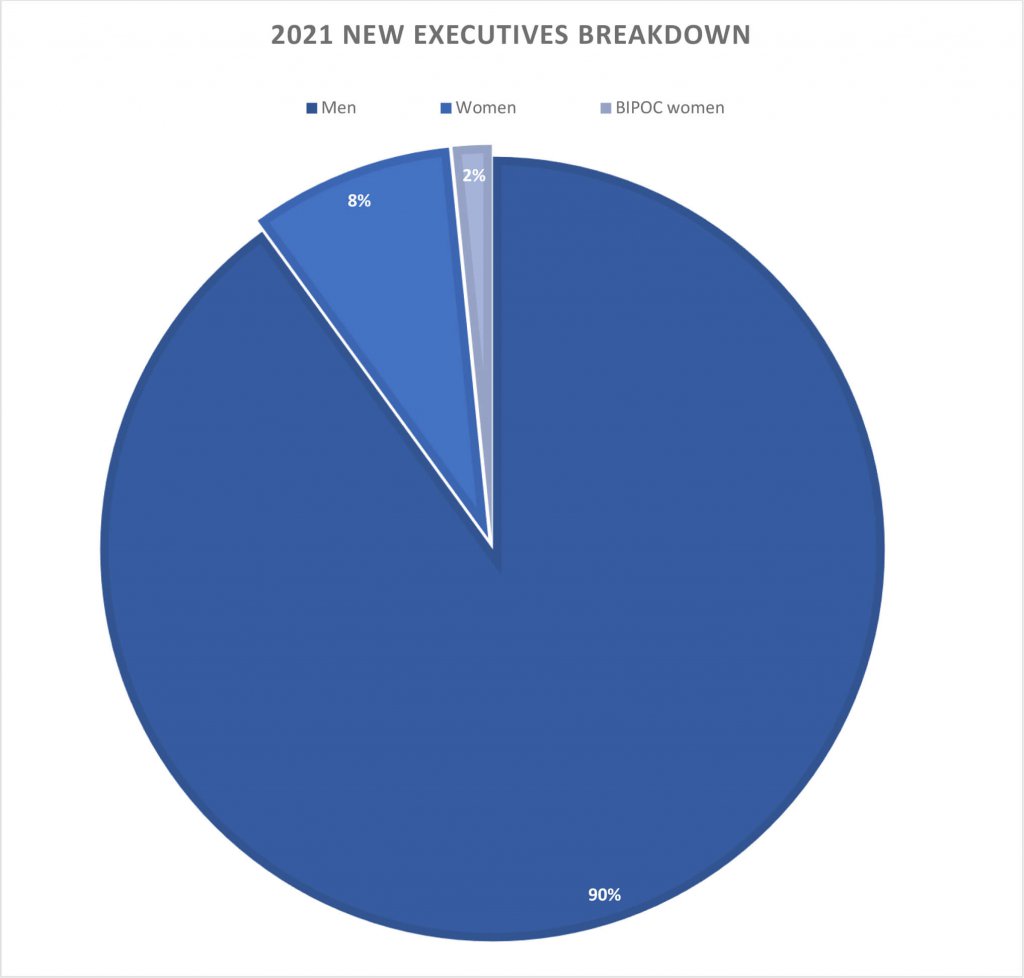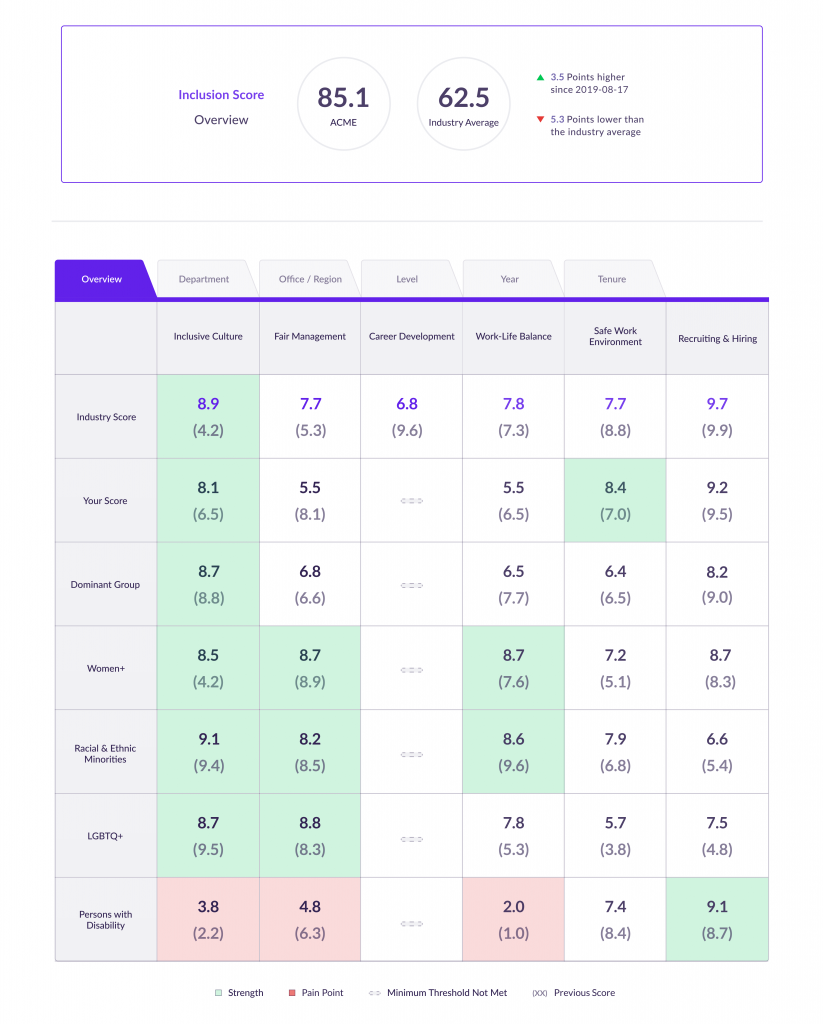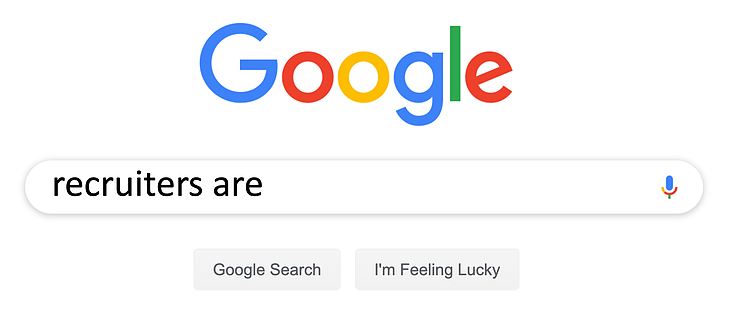A Q&A with Diversio CEO Laura McGee on how equality in promotion and advancement will earn businesses better talent, higher profits and a more attractive brand.
Diversity has become table-stakes for all organizations, whether you’re a startup or a global behemoth.
However, new data from the annual Reisensweig Report is showing that doing it right is no simple task, with women making up only 10% of newly named executives in Canada’s 100 largest companies. BIPOC women comprise less than 2% of that. Despite the overall female exec representation making the jump from 8% the previous year, there is still a long way to go.

The problem comes from policy gaps around the second part of the equation – inclusion. It’s easy to hire for diversity in gender, race, ethnicity, experience or culture. However, that doesn’t amount to much if the fresh faces you’re hiring are still hitting their heads on glass ceilings. Diversity and inclusion together have been proven to boost company profitability, enhance creativity and reduce turnover rates. It also attracts better talent to your hiring funnel.
At Pivot + Edge, we talk a lot about how important it is for startups and scaleups to have an Employer Value Proposition (EVP) and strong employer branding that reflects your company’s cultural values within the C-Suite and your roster of employees. But it’s 2021 and your firm’s EVP will need to encapsulate diversity and inclusion to rank high in authenticity. For more on that, we caught up with Founder and CEO of Diversio, Laura McGee. Her career path has run the gamut from lawyer to consultant to entrepreneur while she worked to improve workplace diversity and inclusion along the way.
Read the full conversation to get insights on how to identify unconscious bias within your team, how to address systemic diversity and inclusion roadblocks and to go over best practices organizations can adopt to create an equitable workplace that attracts great employees.
Pivot + Edge: At what point did you know you wanted to dedicate your career to helping companies enhance their diversity and inclusion practices?
Laura McGee: I actually started my career as a corporate lawyer, then I did it for five minutes and realized I wasn’t very good at it and I moved into consulting. I spent most of my career at McKinsey & Company on the one hand, advising governments on economic growth and on the other hand working with corporates on diversity and inclusion. And that work, made very clear the opportunity to grow both economies and businesses through better talent development and retention, in particular, employees from diverse backgrounds. What I observed, working with the Trump-Trudeau council for advancement of women is that companies have no shortage of commitment to diversity and inclusion but when it comes to “how do I do it?” there aren’t a lot of great tools on the market helping companies make that progress, especially on the inclusion front.
How software platforms can up your diversity and inclusion game
P+E: For those who might never have heard of Diversio – what exactly does the platform do?
LM: Diversio is a software solution for diversity and inclusion. What we do is we collect employee feedback through anonymous surveys and we use that data to help companies create really data-driven action plans and track the progress of those action plans on the employee experience. Ultimately, what the user gets is a dashboard that helps them identify things like harassment or bias or inflexible work. They can then implement programs and policies with a demonstrated track record of creating a better experience.
P+E: How much data do you give to the client? Do they see everything or do you limit them to high-level insights?
LM: We kind of occupy a middle-ground; we deploy the surveys ourselves to employees and we guarantee their anonymity, we say “tell us very candidly about what you like and what you don’t like”, and we’ll communicate the signings to the employer–but we won’t give them the raw data.
“…You need to be creating an environment where people of color have leadership that is invested in them because diversity training only goes so far.”
P+E: You were a contributor to this year’s Rosenzweig report which looks at the top 100 largest publicly-traded firms in Canada and examines how many of the top leadership roles are held by women – here is a quote from that report: “Of the 533 Named Executive Officers, 481 are men, 52 are women, only 8 of which are BIPOC. So, what’s going on here?
LM: A lot of that insight comes from the work we do with companies – at the end of the day you can hire diverse talent but if you’re not giving them the opportunities to advance, mentors, sponsors, safe spaces to do their work, having the opportunity to share their perspective, you’re not going to get them to a place where they can get promoted to the C-Suite. Ultimately, what we’re seeing in Canada is as much a problem of promotion and advancement as it is a problem of hiring and recruiting. The outcome is sad data because the situation is not changing and C-Suites are occupied by the same kinds of individuals and, without being too economical about this, that’s not just holding back companies, that’s holding back Canada because our companies are not going to be able to compete if we don’t have the best talent in the driver’s seat.
Why real inclusion means systemic changes
P+E: So, let’s identify some of the cracks in the veneer, because we’ve been hearing from companies over the last few years that they are trying to be more inclusive, they are implementing diversity training programs, but the data seems to show that there might be some problems with the existing structure of these programs.
LM: What we see is that for most companies the challenges are actually systemic. It’s less about educating people on unconscious bias and more about them saying: “look, we are a bank and we’re not set up to be flexible for working mothers.” And so while you may have the proper day-to-day behaviors and team dynamics – which is very important – you need to be creating an environment where people of color have leadership that is invested in them because diversity training only goes so far. So, we think it’s a combination of systemic changes that you need to take step-by-step. There really is good and bad training and often we’re training the wrong people. Ultimately, the folks that should be trained are often those who identify as part of the dominant group and really are looking for how to be an ally.
P+E: What I’m hearing is that in some cases, when the wrong people are targeted for diversity training it’s less effective and the process becomes a numbers game for companies that want to make sure they look like they have representation and when the diversity roles are filled the initiative gets stuck. In one of your quotes, you say diversity is only half of the equation. What’s the other half?
LM: I believe that focusing on just diversity is a losing game. I think it often creates backlash. You end up with people feeling that the system is rigged one way or the other. We think the ‘secret sauce’ is really promoting inclusion and creating an environment that is equitable for everybody. It’s all about access to opportunities based on how hard you work and what you put in and so a lot of our clients are now tying executive compensation and bonuses to their inclusion scores instead of their diversity performance.
P+E: Where does Canada fall on workplace inclusion and where do most companies have room for improvement?
LM: Canada is doing a pretty good job relative to other countries in hiring for inclusion but not good enough overall. More companies are waking up to the need to adjust their hiring practices, their job postings and are signaling to diverse employees that “look, there is a home for you here and we are actively seeking your perspective.” What’s interesting is that Black Lives Matter shone a very critical light on behalf of people who have been disadvantaged and that was a really important ‘wake-up’ moment. We’re hoping that the next shift will be in inclusion for people with disabilities and for people who identify with having a mental health condition. In our dataset, those folks tend to be the least likely to have mentors and sponsors, the least likely to feel like they are in a safe workspace and that’s often an ‘aha’ moment for our clients because they never really had their attention there.
How to overcome unconscious biases
P+E: If companies have these blind spots, what can they do to make sure their diversity and inclusion practices make more of a positive impact?
LM: It’s all about what you do about it, the commitment, the tracking and the accountability for diversity and inclusion. You start by getting the right mix of people in the room. Then you create the conditions for them to do their best work and contribute to the bottom line. Then you create a system around them that incentivizes and keeps that value and that priority in place. For many organizations that can be the hardest part because you have to change mindsets and change an entire system.
P+E: If you had to grade Canada on its level of diversity and inclusion, what would you give it?
LM: That’s a great question. We do a lot of work in Canada, the U.S., the U.K. and Europe. Canada spikes in certain areas and we also fall behind in certain areas. When it comes to gender advancement, Europe has us beat in a lot of ways both at a policy level and a company level. But in Canada, with the BlackNorth Initiative, a lot of companies took a leadership role on including racial and ethnic minorities, so I think that’s a positive step.
P+E: Can you think of a key example of a company that really understands this and does it well?
LM: I would point to Transalta. They have been a client of ours for quite some time an Alberta-based company with a woman CEO and I think they recognized they needed accountability in their senior leaders – they report on their diversity and inclusion scores in their SEC filings. It’s also on their website and their performance is measured against these metrics. I think that’s really walking the talk.
“You can do the training and the implicit association bias test – that’s all great. But having a metric tied to compensation is a really good way to thank inclusive behavior.”
P+E: This a systemic thing, so I wonder how many of these men, if they aren’t doing this kind of thing intentionally, don’t even realize their unconscious bias? What can we do to clean that up?
LM: A lot of leaders in these organizations are data-driven and so one feature of Diversio’s dashboard is a scorecard that compares the experience of different groups. What we find helpful is that once those leaders who have that unconscious bias look the data in the face it becomes harder to ignore. You can do the training, you can do the behavioral stuff, you can do the implicit association bias test – that’s all great, but at the end of the day, if you have a metric that compensation is tied to, that is a really good way to thank inclusive behavior.

Image: A section from a template of Diversio’s client scorecard. It compares a business’s inclusion rankings to industry benchmarks
Better diversity and inclusion attracts better employees
P+E: We’ve discussed systemic bias, unconscious bias and your data uncovers a lot of that, but what are some red flags that sometimes fly under the radar that CEO’s and managers can actively work to better address in the workplace?
LM: Something we track is the time it takes for an employee to receive a response to his or her message. What we find is that men often receive responses much more quickly than their female colleagues. Being aware of that and addressing it will help female employees be more productive and keep them engaged. So, there are little things like that you can track in real-time on behavior. At this point, most of us are eager to be more inclusive in this special movement, so I think most issues will be found at a granular level.
“76% of job-seekers will go to company websites and look at the make-up of the executive team, they’ll go to Glassdoor and check employer reviews – I think from a brand perspective, there’s no choice but to act on diversity and inclusion at this point.”
P+E: Diversity and inclusion bolsters bottom lines but it also plays a big role in the employer brand – it is both internal and external facing, it impacts candidate decisions about how they feel about a company they are considering. What kind of data are you seeing on this? Are more diverse and inclusive firms getting the best talent?
LM: Absolutely. After Black Lives Matter became really active last summer, we analyzed different companies’ responses to the movement. What we found was that companies see having a position on the matter was table stakes at this point – brands are expected to say something and saying nothing was out of the question. We used AI and we analyzed Twitter reactions to these statements and we found that the ones that elicited backlash were from companies that really contradicted what they said. Employees of color would come out and challenge their CEO’s words because they experienced racism on the job. That’s not a good look. On the flip-side, the companies that were really well-received, like Ben & Jerry’s, which has had a really solid history and track-record of creating an inclusive workplace and then being engaged in the community. This generation is extremely smart and doing their due diligence. 76% of job-seekers will go to company websites and look at the make-up of the executive team, they’ll go to Glassdoor and check employer reviews – I think from a brand perspective, there’s no choice but to act on diversity and inclusion at this point.
P+E: What are the telling differences between companies that really get diversity and inclusion and those that are missing the mark or coming off as disingenuous?
LM: We see a clear correlation in relationship between companies that have an inclusive culture and those that are well-regarded by customers. If you have people on your marketing team who ‘get it’ and a marketing team that is composed of diverse individuals, they’ve got their ear to the ground often, they can speak the language so that the message doesn’t fall flat, it comes out as authentic. At the same time, those people need to believe in their company and stand for what they are saying. People are people and lying authentically is hard. The best thing you can do is create an environment that is diverse and inclusive. Ultimately, they are going to create content that resonates with that audience.
P+E: Do you have any anecdotal experience facing barriers with diversity and inclusion that might have pushed you to where you are and what you’re doing today?
LM: I was very lucky to have Dominic Barton as a mentor at McKinsey & Co. He was the global Managing Director at the time and he was so generous with me when I was starting out. He would take me to all the senior-level meetings that he was involved in – which was, you know, the right thing to do because I was doing all the work – but there were countless times when I would walk in and my hand was not shaken and I was assumed to be taking the coffee orders, I wasn’t addressed when sitting at the table or asked for my opinion, I had to jump up and share it. I had to build up accountability way more than some of my male colleagues and that was just annoying because I thought “I know this better than you do!” And that sort of spoke to me because how many women or people of colour can you imagine have the right answer at these meetings but are not as vocal as I am? And that’s not helping anybody.
P+E: In some places, discrimination and workplace imbalances are still a clear reality, but collectively we have made strides to do and be better. In 2021, how much further do we have to go?
LM: We’re on a long journey right now, we’ve made strides on gender inclusion, we’re chipping away on racial and ethnic inclusion, but we have a long way to go for people with disabilities, people with mental health issues, LGBTQ2+ inclusion – the more we focus on what systemic changes we can make to empower all employees regardless of background and identity, the more we’re going to help all of those groups. Not to be a tech nerd, but what we’re doing, analyzing massive sets of data from around the world to uncover best practices and discovering clever, creative programs that are hacking their way to a more inclusive workplace – that to me is encouraging. The quicker we can get that information and those case studies in the hands of companies, the quicker they can make that progress; I am optimistic it won’t be 200 years to gender equity like the World Economic Forum suggested.
End of interview
Despite improvements, diversity and inclusion still have some hurdles to jump before we can pass medals around. Systemic problems in D+I exist primarily in larger companies because they are stuck in their old processes. It’s not completely their fault – the bigger the ship, the more time it takes to change direction. This is especially true if the top executives are outperforming in the best interests of their stakeholders. The kind of work that Laura does for these businesses is so important. It emphasizes how crucial it is that new startups and scaleups have diversity and inclusion baked in from the start. Doing so they can help the little guys avoid big problems – and it’s also just the right thing to do.
______________________________________________________________________________________________________________________________________
This spot looks as good as any for a timely plug. Diversio focuses on helping businesses identify problems with their diversity and inclusion practices. But for some startups, the issue is getting enough candidates through the door. Pivot+Edge is a hiring solution that builds and amplifies your employer brand so that quality candidates fill your job funnel.
And while ensuring diversity isn’t our top focus, matching you with perfect fits for your firm definitely is. So if you commit to diversity and inclusion, you can bet they will be too. If that sounds like a partnership you’d like to pursue, then stop struggling to hire and get in touch with us and we’ll take it from there.







